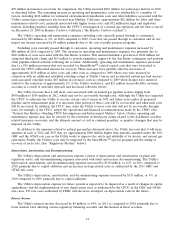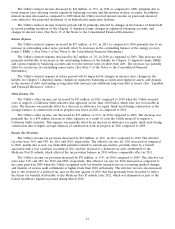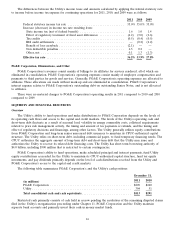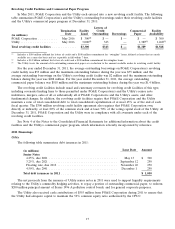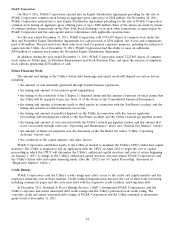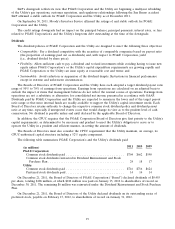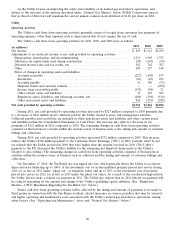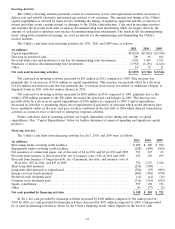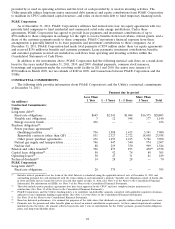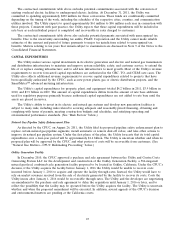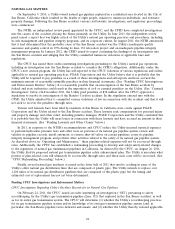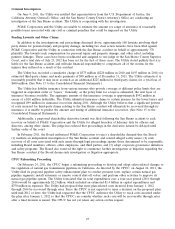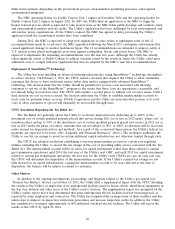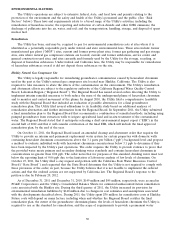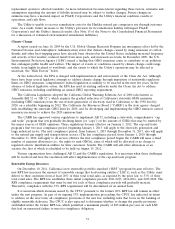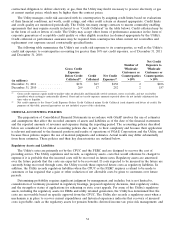PG&E 2011 Annual Report Download - page 28
Download and view the complete annual report
Please find page 28 of the 2011 PG&E annual report below. You can navigate through the pages in the report by either clicking on the pages listed below, or by using the keyword search tool below to find specific information within the annual report.NATURAL GAS MATTERS
On September 9, 2010, a Utility-owned natural gas pipeline ruptured in a residential area located in the City of
San Bruno, California which resulted in the deaths of eight people, injuries to numerous individuals, and extensive
property damage. Following the San Bruno accident, various civil lawsuits, investigations, and regulatory proceedings
were commenced.
The NTSB, an independent review panel appointed by the CPUC, and the CPSD have completed investigations
into the causes of the accident, placing the blame primarily on the Utility. In June 2011, the independent review
panel issued a report that was highly critical of the Utility’s natural gas operating practices and procedures, including
its risk management and pipeline integrity programs, and its corporate culture. In August 2011, the NTSB announced
that it had determined that the probable cause of the San Bruno accident was the Utility’s inadequate quality
assurance and quality control in 1956 during its Line 132 relocation project and an inadequate pipeline integrity
management program. In January 2012, the CPSD issued its report containing the findings of its investigation into
the San Bruno accident and alleging that the Utility committed numerous violations of applicable laws and
regulations.
The CPUC has issued three orders instituting investigations pertaining to the Utility’s natural gas operations,
including an investigation into the San Bruno accident to consider the CPSD’s allegations. Additionally, under the
CPUC’s new citation program, the Utility has self-reported to the CPUC violations of various regulations and orders
applicable to natural gas operating practices. PG&E Corporation and the Utility believe that it is probable that the
Utility will be required to pay penalties as a result of these investigations and self-reports and have accrued the
minimum amount of reasonably estimable penalties in their financial statements. (See ‘‘Pending CPUC Investigations
and Enforcement Matters’’ below.) It is reasonably possible that an investigation of the San Bruno accident by
federal and state authorities could result in the imposition of civil or criminal penalties on the Utility. (See ‘‘Criminal
Investigation’’ below.) In December 2011, the Utility paid penalties of $38 million after the CPUC approved a
stipulation to resolve its investigation of the Rancho Cordova accident. In the stipulation entered into with the
CPSD, the Utility admitted that it committed various violations of law in connection with the accident and that it will
not seek to recover the penalties through rates.
Various civil lawsuits have been filed by residents of San Bruno in California state courts against PG&E
Corporation and the Utility related to the San Bruno accident. These lawsuits seek compensation for personal injury
and property damage and other relief, including punitive damages. PG&E Corporation and the Utility concluded that
it is probable that the Utility will incur losses in connection with these lawsuits and have accrued an amount in their
financial statements. (See ‘‘Pending Lawsuits and Other Claims’’ below.)
In 2011, in response to the NTSB’s recommendations and CPUC orders, the Utility incurred material expenses
to perform hydrostatic pressure tests and other tests on portions of its natural gas pipeline system, review and
validate its pipeline records, install automatic or remote shut-off valves on certain pipelines, revise its pipeline
integrity management program, and perform other activities related to the safety of its natural gas pipeline system.
As described above in ‘‘Operating and Maintenance,’’ these pipeline-related expenses will not be recovered through
rates. Additionally, the CPUC has established a rulemaking proceeding to develop and adopt safety-related changes
to the regulation of natural gas transmission pipelines in California. As directed by the CPUC, on August 26, 2011,
the Utility filed its proposed natural gas transmission pipeline safety enhancement plan. The Utility is uncertain what
portion of plan-related costs will ultimately be recoverable through rates and when such costs will be recovered. (See
‘‘CPUC Rulemaking Proceeding’’ below.)
Finally, several natural gas incidents occurred in the latter half of 2011 that involve cracking in some of the
Utility’s older natural gas distribution lines that are composed of plastic pipe. The Utility intends to replace over
1,200 miles of its natural gas distribution pipelines that are composed of this plastic pipe but the timing and
estimated cost of replacement has not yet been determined.
Pending CPUC Investigations and Enforcement Matters
CPUC Investigation Regarding Utility’s Facilities Records for its Natural Gas Pipelines
On February 24, 2011, the CPUC issued an order instituting an investigation (‘‘OII’’) pertaining to safety
recordkeeping for the Utility’s gas transmission pipeline (Line 132) that ruptured in the San Bruno accident, as well
as for its entire gas transmission system. The CPUC will determine (1) whether the Utility’s recordkeeping practices
for its gas transmission pipeline system and its knowledge of its own gas transmission pipeline system (and, in
particular, the San Bruno pipeline) were deficient and unsafe, and (2) whether the Utility thereby violated applicable
24


